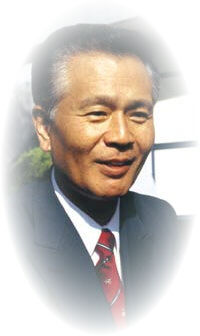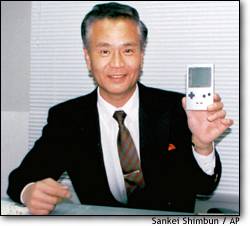|

Gunpei Yokoi
The man behind Nintendos pocket rocket
Here is profile of another of Nintendo's finest men. He was the brain behind both the fantastic Game&Watch games, the Game Boy and unfortunately also behind the Virtual Boy. The Metroid games in conjunction with S.Miyamoto and Kid Icarus for the NES.
Gunpei Yokoi grew up in Kyoto. His father was a director of a pharmaceutical company. After Gumpei graduated from college with a degree in electronics he started looking for a job and was hired by Hiroshi Yamauchi to maintain the assembly line famous for Hanafunda cards.
The Ultrahand and other Toys...
In 1970 he was assigned to a new project in the new games department. He was told by Hiroshi to do something for the "Christmas Rush". When Gunpei asked what Hiroshi had in mind he just said "something great". Gunpei worked under Imanishi to create a department for Komuki Engineering. The next day he introduced them to an expansion arm toy that he had designed before, purely for his own amusement. This was actually Nintendo's first ever toy and was named the Ultrahand, they sold over 1.2 million units for about 800 Yen each. After that he created more great toys such as the baseball-throwing machine for homes called the Ultra Machine (seems Nintendo have always had a fascination in the name Ultra, Ultra 64 anyone?) This machine lobbed a softer version of a baseball that could be safely hit even indoors. The next thing in the "Ultra series" was a little periscope called you guessed it, the Ultra Scope used to look around corners and over fences etc (the mind boggles!) This toy never sold in any great quantities though (is it any surprise). The next invention from Gunpei was a Love Tester that actually became a big hit in Japan. It involved a girl and boy (presumeably) holding each others hands and with their free hands holding the two handles inside the machine (ohh, err....). The machine then tested how much love was flowing between them (actually the machine only read the current passing through the two, it had nothing to do with any love or emotions, can you imagine the arguments this machine caused!!). Gunpei loved his work and he saw himself as "a cartoonist who understood movements in the world and created abstractions of them" (Gunpei's own words)
Gunpei joins up with Masayuki.
After the success of the love tester Gunpei Yokoi hired Masayuki Uemoura from Sharp and they began developing the Nintendo Beam Gun games using the solar cells from Sharp.They began experimenting with solar cells to be used as sensors to detect light coming from, for example a lightgun. They began planning, on a cheap lightgun that could be sold to the consumer market. At last the Nintendo Beam Gun Games consisting of a lightgun and some targets (with solar cells mounted on them) were out on the market and sold over 1 million units, they were sold for somewhere between 4000 and 5000 Yen.
Game & Watch
When Hiroshi Yamauchi declared that Nintendo would start to sell videogames instead of toys Gunpei was asked to create "something new" and he designed a series of cheap handheld machines with LCD-display best known as Game & Watch Gunpei also invented the now legendary "control-cross" or D-pad that is still used on the videogame consoles even today!! The G & W games became a huge success worldwide (we are even starting to see emulations of these games). One guesstimate is that 40 million people owned a Game & Watch at the height of the craze.
The basic G&W design leans heavily on the side of portability, at the expense of technology. Most units were not much bigger than a credit card or wrist watch and featured a fairly small LCD graphic display. Although this design may have had its doubters, going to the other extreme would have been a pointless and ultimately thankless task. For,one the technology was not as advanced as that used on later models (such as the Game Boy!) and a more hi tech Game & Watch would entail a higher level of research and developement. The net result would have been a unit not much smaller than a home computer and pretty much the same price tag!!. As it stood, the final design allowed for relatively inexpensive production whilst still maintaining a sleek, portable product. Of course, gameplay was also very much a high-riding factor- design work counts for nothing if no-one wants to lower themselves to play sub-standard games.
Although a good percentage of initial G&W titles were nothing more than bog standard reaction testers, Nintendo soon began producing titles that stretched both the technology and the imagination of the user! Popular arcade titles such as the eminent Donkey Kong were given Game & Watch translations, even the highly successful Super Mario Bros appeared in LCD form. This was also one of the first titles to have a scrolling landscape.The G&W series of games stretched to an unbelievable 59 titles between 1980 and 1986
During this time Hiroshi also teamed Gunpei Yokoi with Shigeru Miyamoto, there task was to create a new type of video game, with Yokoi responsible for the Hardware side of developement the game in question as previously covered in my Miyamoto feature was, Donkey Kong.
The Masterpiece!!
In 1989, Yokoi's research and development team came out with a masterpiece- Game Boy. Game Boy was not the first programmable hand held game console, Milton bradley had released one years earlier. but Game Boy was inexpensive, had reasonably clear graphics, and had enough processing power to play a large libraryof games. Sales of this pick up and play virtually anywhere console went through the roof but by 1995 it's popularity was beginning to wane. In 1986, Yokoi updated the Game Boy by making it smaller and adding a higher-resolution screen. He called the new unit the Game Boy Pocket. Game Boy remains the most popular handheld game system, giving it the record for the longest retail life of any game system in history. Nintendo has sold over an incredible 55 million of the machines( this doesn't include the since released Game Boy Color)
The Master's Downfall
The Virtual Boy, designed by Yokoi, never took off. In 1995, Yokoi designed the ill-fated Virtual Boy, a game console that featured high-resolution 3D graphics. The system, which used single color light emitting diode technology, was a marketing disaster for Nintendo because consumers were not ready to purchase a game console that only had red and black graphics. It can also be said that Nintendo did not properly support Virtual Boy. Miyamoto, Nintendo's master game designer, was to busy creating Nintendo 64 games to work on any Virtual Boy projects. Rare, the firm that designed the Donkey Kong Country and Killer Instinct games, were to busy building Super Nintendo and Nintendo 64 cartridges to concentrate on Virtual Boy. With little software support and dwindling consumer interest, Virtual Boy sold poorly in the USA and even worse in Japan (over here in UK we were spared the pain). After a dismal first year of sales, retailers dropped the price from $149 to $99 and eventually as low as about $25. Rumours circulated around the video game industry that Yamauchi blamed Yokoi for the product's failure. When Nintendo unveiled the Nintendo 64 at a special trade show in Tokyo in 1995, Yokoi remained in a quiet section of the show floor demonstrating new games for the VB. The games were never published. The Nintendo 64 with its 64-bit, 16 million colour producing game processor had overshadowed Yokoi's gadget.
Leaving Nintendo
Yokoi left Nintendo on the 15th August 1996, and founded a handheld game company called Koto. Despite all of the rumors about Yamauchi blaming him for Virtual Boy, Yokoi remained close to Nintendo and consulted for the company. Yokoi, the dean of Nintendo's engineers, was an extremely humble man who always preferred talking about his companies success to taking credit for his own accomplishments. "I've known Mr. Yokoi for a long time. He had a great sense of humor, a great smile... a very generous and outgoing fellow." said Howard Lincoln (head of Nintendo of America). "He made a tremendous amount of creative contributions to Nintendo and the video game business over the years. People play Game Boy all over the world, and that's Mr. Yokoi's."
Gunpei Yokoi was tragically killed in a car accident in 1997. An unfitting end to one of the greatest hardware designers of all time.
Written by Steve Ingers

|

